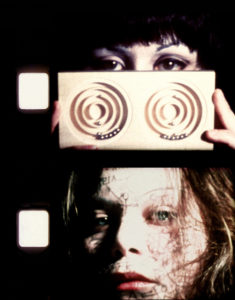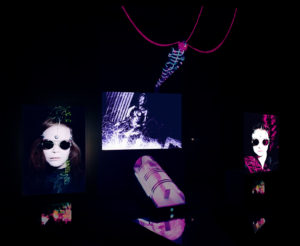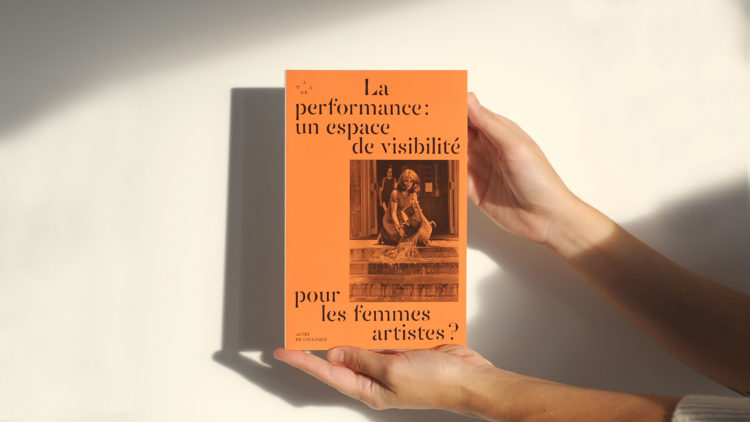Prix AWARE
Reciprocal photographic portraits from the Tri-X-Pan Double Exposure series, 1977
©Klonaris/Thomadaki
Since the late 1960s, the duo and couple formed by Maria Klonaris and Katerina Thomadaki have continually sought to invent a language of “liberty” within “the power-wrought language” that is art and representation.1 Confronting issues linked to masculine/feminine relations and to gender, to the body and to domination, the artists have simultaneously asserted their political engagement and their extreme formal precision, conscious that artistic forms themselves produce feminist statements. Abundant, their work is carried by the “dissident body”, which “does not conform to norms” nor to “the tyranny of normality […] exerted by the gaze”.2 Avant-garde and powerful, creator of breaches, their work has profoundly renewed experimental cinema and the visual arts, and has been duly recognised in France and abroad.

Maria and Katerina, stills from the film Double Labyrinthe, 1976
©Klonaris/Thomadaki

Maria in La Torture, collective performance conceived by Klonaris/Thomadaki, Cartoucherie de Vincennes, 1976
©Klonaris/Thomadaki
Born respectively in Cairo in 1950 and in Athens in 1949, Klonaris and Thomadaki quickly gained recognition in Greece, one for her drawings and illustrations, the other for her stage productions and essays on theatre. Following their move to Paris, they became known for Double Labyrinthe (1975-1976), which they filmed mutually on Super 8, exploring their bodies with the camera. La Torture (1976), a performance which led to a filmed “constat [proof or report]”, also had a certain resonance. They theorised a “cinema of the body”, in reference to the “body art” of Michel Journiac and Gina Pane, and in dialogue with feminist thoughts and movements; this theory is embodied by cycles such as La Tétralogie corporelle (1975-1979) and Le Cycle de l’Unheimlich (1977-1982). Their relationship with each other, one body with another, but also with other bodies, permeates their work. It is also apparent in Personal statement (1994), a video from Cycle de l’Ange, or in Sauro Bellini (1982), portrait of an androgyne body.

Unheimlich III : Les Mères, performance/installation, commissioned by the Centre Pompidou, cinéma du Musée, 1981
©Klonaris/Thomadaki
Klonaris and Thomadaki use the notion of femininity to question the construction and representation of the woman as “other”. Their “radical femininity” means “questioning how we define the sexes”: it means positioning themselves “as subjects seeing and subjects seen”, building “a feminine subject of enunciation” which “assumes an ideological position that is not masculine or androcentric”. Citing Pierre Bourdieu, they state that they want to convert “
the passive body” into “an active and acting body”.3 Metaphorical, their work is fascinated with rites and myths as a means of confronting great symbolic systems. In 1977 they published a “Manifesto for a Radical Femininity, for Another Cinema”, and in 1978, a “Manifesto for a Cinema of the Body”. 4 They also express their reluctance concerning the categories of homosexual and heterosexual.

Mystère I : Hermaphrodite endormi/e, space view, 12th Paris Biennale, Musée d’art Moderne, 1982
©Klonaris/Thomadaki

Orlando-Hermaphrodite II, commissioned by the Journées Audiovisuelles internationales, Grande salle, Centre Pompidou, 1983
©Klonaris/Thomadaki

Le Rêve d’Electra, Joan Miro Foundation, Barcelona, exhibition, “Antiquity and Modernity in Twentieth-Century Art” curated by Gladys Fabre, 1991
©Klonaris/Thomadaki
In the early 1980s, the two artists took up the idea of expanded cinema, wanting to go beyond traditional projection and to move the boundaries between mediums, by developing environments and installations. L’Hermaphrodite endormi/e is a complex installation that was presented at the Paris Biennial in 1982, bringing together multiple beams, light reflections, and sound. In 1983, in the main theater of the Centre Pompidou, they presented Orlando – inspired by Virginia Woolf’s novel – which featured an imposing 7 synchronised projections of the artists, “actantes” (the French term they chose, instead of “actress”), live. Le Rêve d’Electra, a reappropriation of the myth of Electra, was shown in France and abroad during this decade. Their reflection on “hybridisation” impacted the categories of visual art and aesthetics as much as it did categories, norms, and boundaries of gender, opening up discussions about transgenderism, intersexuality, and binarity. Le Cycle de l’Ange, created in 1985 following their discovery of a photograph of an intersex person, continues this work.

Requiem pour le XXe siècle, video, 1994, Unesco and European Council Prize, Locarno Festival, 1995
©Klonaris/Thomadaki
In the 1990s, computers and their possibilities infused their photo and video work. Requiem pour le XXe siècle (1994), a montage of images of wars and genocides set to music by Spyros Faros, haunted by the “technologies of destruction” and the “persecution of sexual difference”, gave rise to multi-screen installations. Sound was an essential component: Klonaris and Thomadaki also created sound art, notably for France Culture’s Ateliers de création radiophonique.

Night Show for Angel, la piscine. Hornsey Road Baths, installation in situ, commissioned by the Edge Biennial, London 1992
©Klonaris/Thomadaki
Activists, Klonaris and Thomadaki wanted to intervene in the art ecosystem. In doing so, like other women artists elsewhere in the world, they brought about a political tradition in which changing art does not simply mean producing new visual artforms, but goes hand in hand with a radical transformation of the conditions of creation, production, and circulation of artworks. They wrote theoretical texts and manifestos, on a “cinema of rupture” (1976) and on Super 8, on artistic institutions, competition (1977 and 1980), and independence (1978) (an independence that they practised, away from the art market).5 They led technical workshops for women, allowing them to take up a camera at a time when technique was the preserve of men. They organised screenings and programmes, linking together different practices, associating their work with that of others, in France and abroad. The association ASTARTI that they created in 1985 seeks to promote links between art and feminism. The international event “Rencontres internationales art cinéma/vidéo/ordinateur” celebrated the breaking down of barriers between mediums: “Technologies and imaginaries” in 1990, “Mutations of the image” in 1994, “Towards a media ecology” in 1998.
Following the sudden death of Maria Klonaris in January 2014, Katerina Thomadaki continues their joint work alone, pursuing the development of an oeuvre that is not closed (and which is far from limited to the works cited here), publishing Maria’s poems and drawings (Dark Shot, 2018) with energy and love.6 Because, as the “Manifesto for a Cinema of the Body” stated, love and desire have never been disassociated from revolution and rebelliousness: if “my creation is desire for an untamed rupture with imposed codes” then “my images are the glitters of an amorous gaze”, “my gaze is madness of touch”.7
Antoine Idier
‘Rites de l’intelligence et films cultes. Entretien avec Nicole Brenez’, Klonaris/Thomadaki, Stranger Than Angel, Ljubljana, Cankarjev Dom, 2002, p. 93.
2
Alex Cécile Chich, ‘Introduction’, in Alex Cécile Chich (ed.), Klonaris/Thomadaki. Le Cinéma corporel, Paris, L’Harmattan, 2006, p. 20.
3
« Rites de l’intelligence et films cultes… », op. cit., p. 94-95.
4
Klonaris/Thomadaki, ‘Manifeste pour un cinéma corporel’, Manifestes. 1976-2002, Paris, Paris Expérimental, 2003.
5
Klonaris/Thomadaki, Manifestes, op. cit.
6
Klonaris/Thomadaki, Dark Shot, Paris, ASTARTI, 2018.
7
« Manifeste pour un cinéma corporel », op. cit.
Tous droits réservés dans tous pays/All rights reserved for all countries.






